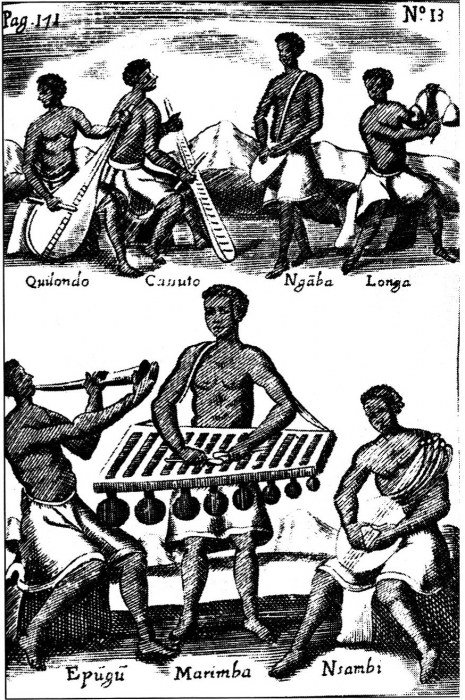
マリンバ
Marimba

An
array of named instruments in the Kongo Kingdom by Girolamo Merolla da
Sorrento (1692)
☆ マリンバ(/məˈrɪmbə/ mə-RIM-bə)は、木製の棒をマレットで叩いて音を出す打楽器の一種である。各棒の下には共鳴管があり、特定の倍音を増幅する。木琴に比べ、マリン バの音域は狭い。通常、マリンバの棒はピアノの鍵盤のように半音階に配列されている。マリンバは、体鳴楽器の一種である。 今日、マリンバはソロ楽器として、あるいはオーケストラ、マーチングバンド(通常はフロントアンサンブルの一部として)、パーカッションアンサンブル、ブ ラスバンド、コンサートバンド、その他の伝統的なアンサンブルなどのアンサンブルで使用されている。
| The marimba
(/məˈrɪmbə/ mə-RIM-bə) is a musical instrument in the percussion family
that consists of wooden bars that are struck by mallets. Below each bar
is a resonator pipe that amplifies particular harmonics of its sound.
Compared to the xylophone, the marimba has a lower range. Typically,
the bars of a marimba are arranged chromatically, like the keys of a
piano. The marimba is a type of idiophone. Today, the marimba is used as a solo instrument, or in ensembles like orchestras, marching bands (typically as a part of the front ensemble), percussion ensembles, brass and concert bands, and other traditional ensembles. |
マリンバ(/məˈrɪmbə/
mə-RIM-bə)は、木製の棒をマレットで叩いて音を出す打楽器の一種である。各棒の下には共鳴管があり、特定の倍音を増幅する。木琴に比べ、マリン
バの音域は狭い。通常、マリンバの棒はピアノの鍵盤のように半音階に配列されている。マリンバは、体鳴楽器の一種である。 今日、マリンバはソロ楽器として、あるいはオーケストラ、マーチングバンド(通常はフロントアンサンブルの一部として)、パーカッションアンサンブル、ブ ラスバンド、コンサートバンド、その他の伝統的なアンサンブルなどのアンサンブルで使用されている。 |
Etymology and terminology An array of named instruments in the Kongo Kingdom by Girolamo Merolla da Sorrento (1692) The term marimba, refers to both the traditional version of this instrument and its modern form. Its first documented use in the English language dates back to 1704.[1] The term is of Bantu origin, deriving from the prefix ma- meaning 'many' and -rimba meaning 'xylophone'. The term is akin to Kikongo and Swahili marimba or malimba.[2] |
語源と用語 ソレント出身の画家ジローラモ・メロッラによるコンゴ王国で用いられていた楽器の図(1692年) マリンバという用語は、この楽器の伝統的なバージョンと現代的なバージョンの両方を指す。英語での最初の使用例は1704年にさかのぼる[1]。この用語 はバンツー語族に由来し、接頭辞の ma-(「多数」)と-rimba(「木琴」)に由来する。この用語は、キコンゴ語やスワヒリ語の marimba または malimba に近いものである[2]。 |
| History Ancient See also: Xylophone § History 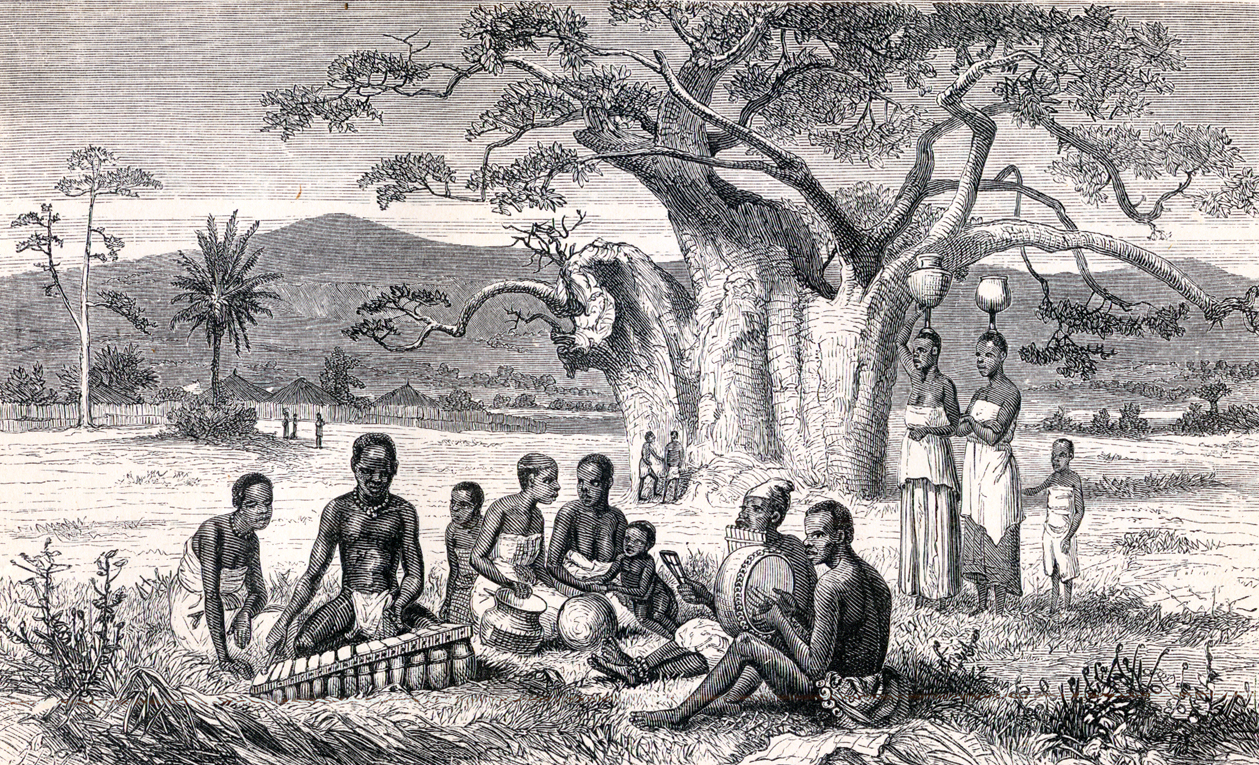 Marimba players in Africa Instruments like the marimba are present throughout the entirety of sub-Saharan Africa.[3] The instrument itself is most similar and shares its name with the marimbas of modern-day Angola and the Democratic Republic of the Congo.[4] However, it is also similar to instruments that exist in West Africa such as the balafon of the Mandinka people, known as gyil among the Gur peoples in and around northern Ghana and Burkina Faso.[5] Central America See also: Music of Guatemala § Marimba 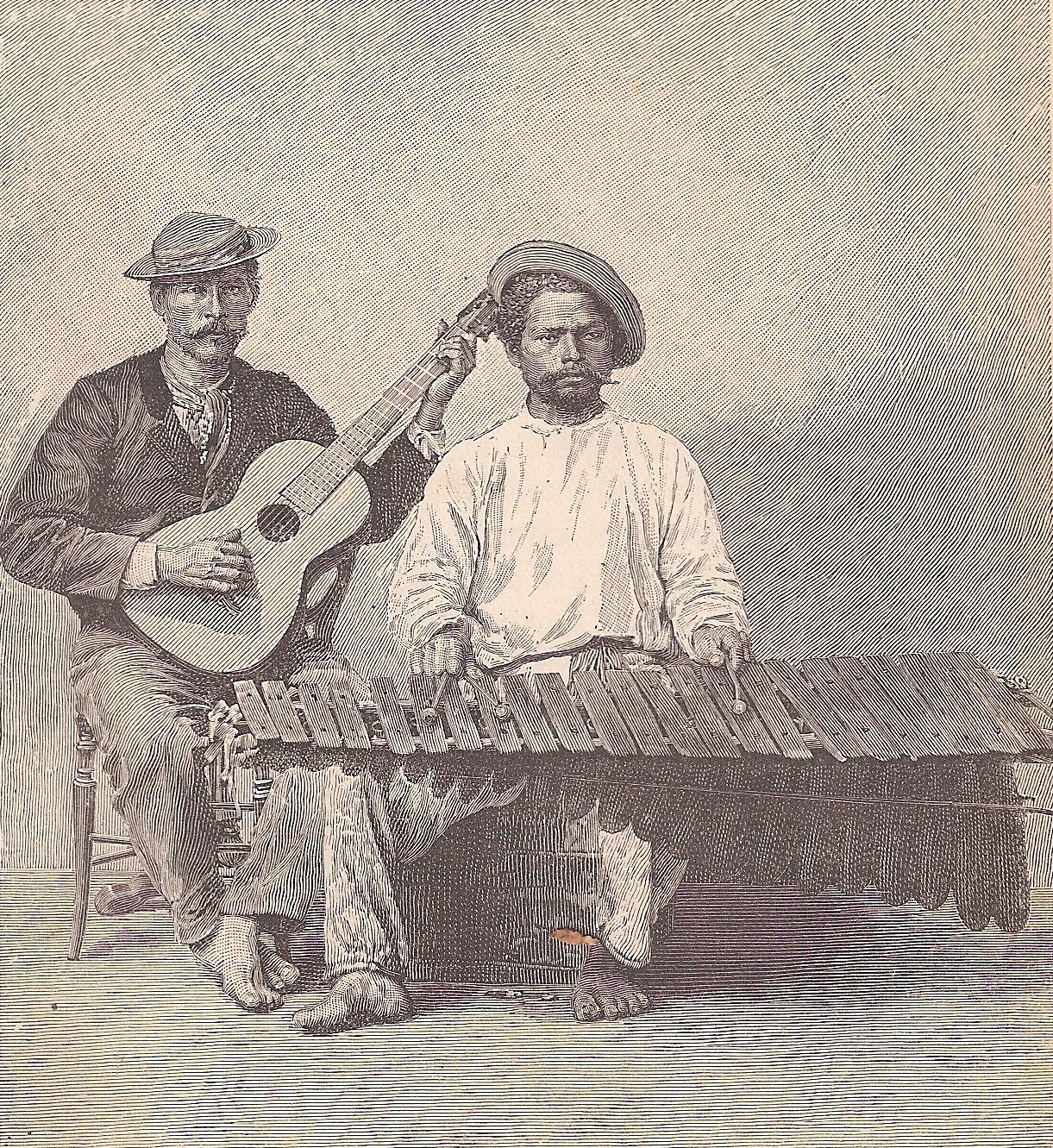 "The Marimba" from "The Capitals of Spanish America" (1888) The marimba is popular throughout Central America, with its popularity spreading from southern Mexico to Costa Rica. The first historical account in Central America is from 1550 where enslaved Africans in Guatemala are reported playing it. By 1680 accounts of Maya musicians using marimbas with gourd resonator were made in Guatemala. It became more widespread during the 18th and 19th centuries, as Maya and Ladino ensembles started using it on festivals. In 1821, the marimba was proclaimed the national instrument of Guatemala in its independence proclamation.[6] South America See also: Music of Colombia § Pacific Region of Colombia, and Music of Ecuador § Afro-Ecuadorian music 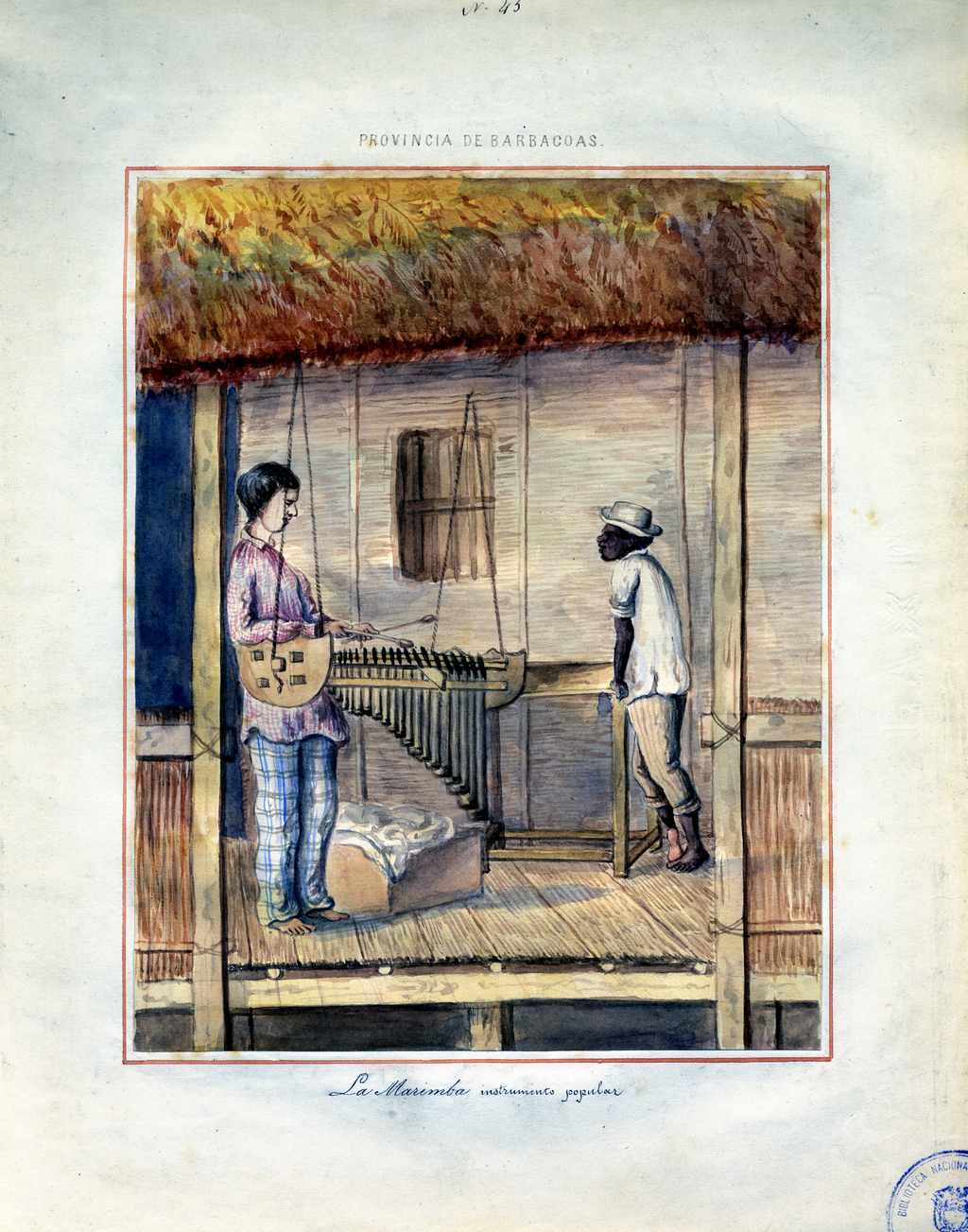 A watercolor of marimbas by Manuel María Paz from the Province of Barbacoas in Colombia (1853) Marimba's second range of popularity in Latin America is in the Pacific coast of Colombia and Ecuador.[7] The instruments were brought there via the African diaspora and their cultural significance has survived to the present day.[8] The Afro-Latino communities that take part in preserving and playing it value its importance as a touchstone of their resilience.[9] 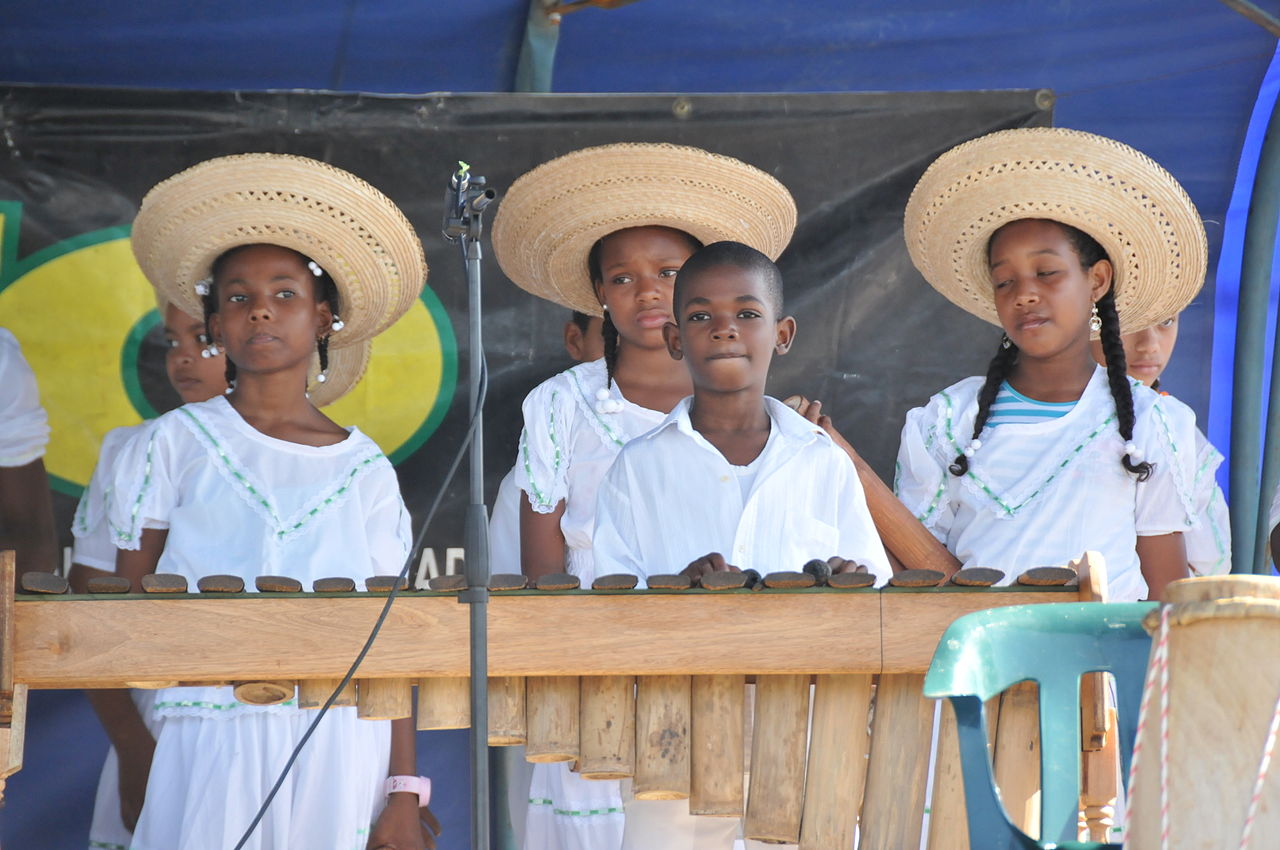 Afro-Colombian youth playing the marimba de chonta In Colombia the most widespread marimba is the marimba de chonta (peach-palm marimba). Marimba music has been listed on UNESCO as an intangible part of Colombian culture.[10] In recent times marimberos (marimba players) and the marimba genres as a whole have started to fade out in popularity.[8] Nonetheless, the genre is still popular in the departments of Chocó and Cauca.[11] 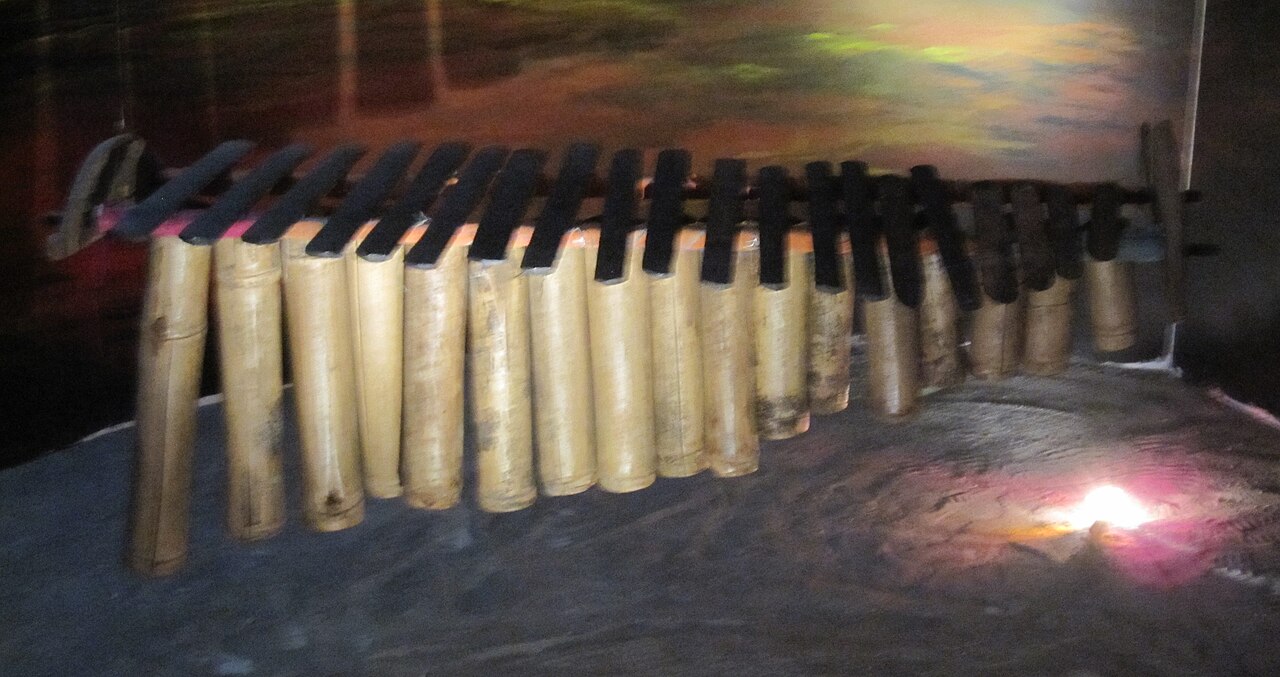 An example of the Afro-Ecuadorian marimba esmeraldeña In Ecuador the most widespread marimba is the marimba esmeraldeña (Esmeralda marimba).[12] Marimbas are an important aspect of Afro-Ecuadorian culture: many religious ceremonies and songs are accompanied with marimba music along with festivals and dances.[12][13] It is most popular in the province of Esmeraldas where in the 16th century Alonso de Illescas, a maroon, found a maroon settlement near the area around modern day Esmeraldas. In that province, it evokes a sense of pride for the community in which years centuries marimba music has been prohibited after government encroachment upon the Esmeraldas province.[14] Modern 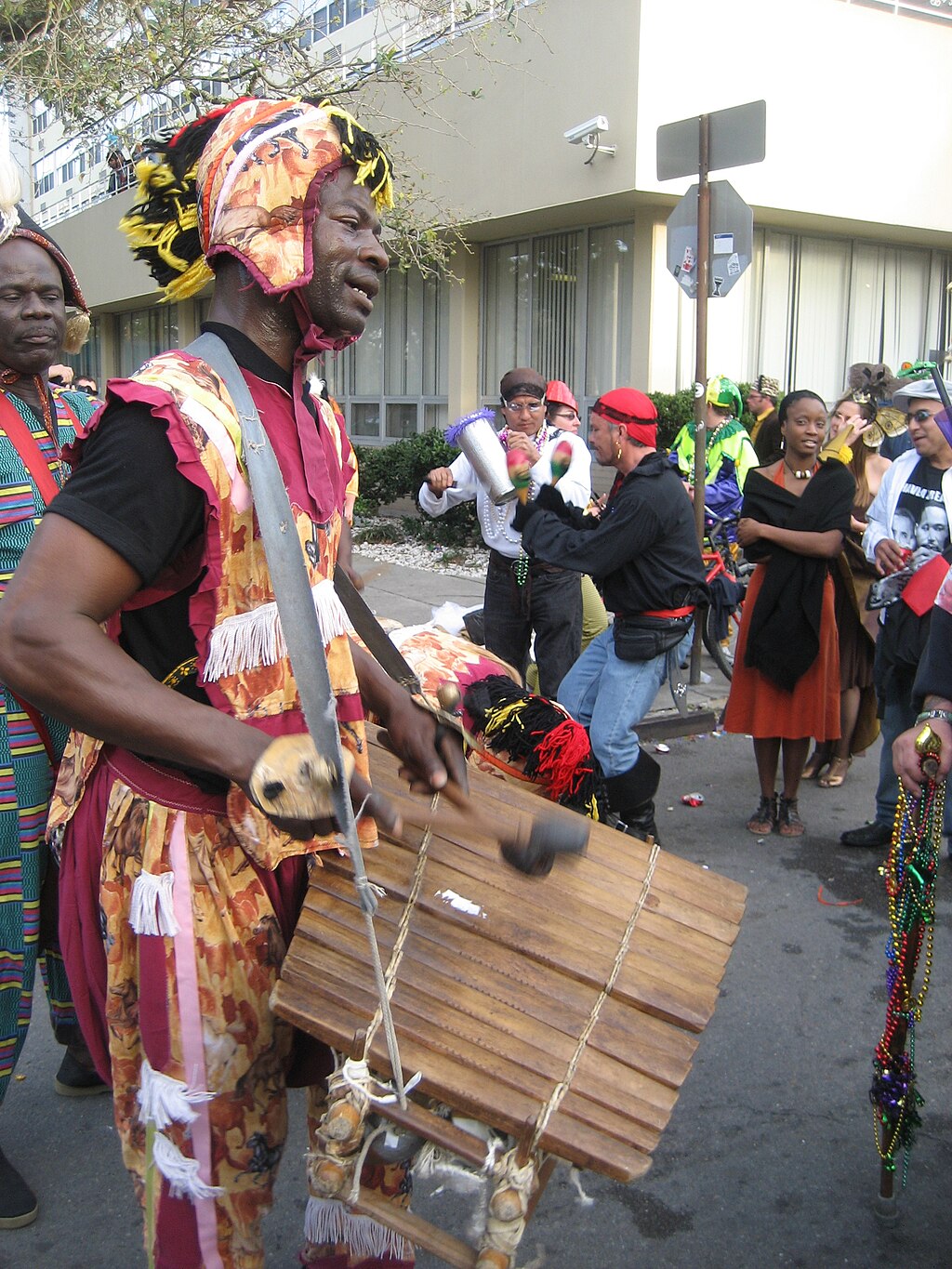 A marimba player on the streets of New Orleans, Louisiana, during Mardi Gras Marimbas have become widely popular around the world since it was being used throughout Africa, Southeast Asia, Europe, North America, South America and Central America.[15] In 1850, Mexican marimbist Manuel Bolán Cruz (1810–1863), modified the old bow marimba, by the wooden straight one, lengthening the legs so that the musicians could play in a standing mode, expanded the keyboard and replaced the gourd resonators by wooden boxes. In 1892, Mexican musician Corazón de Jesús Borras Moreno [es] expanded marimba to include the chromatic scale by adding another row of sound bars, akin to black keys on the piano.[16] The name marimba was later applied to the orchestra instrument inspired by the Latin American model. In the United States, companies like J.C. Deagan and the Leedy Manufacturing Company adapted the Latin American instruments for use in Western music. Metal tubes were used as resonators, fine-tuned by rotating metal discs at the bottom; lowest note tubes were U-shaped. The marimbas were first used for light music and dance, such as vaudeville theater and comedy shows. Clair Omar Musser was a chief proponent of marimba in the United States at the time. In 1940, the American composer Paul Creston wrote the first composition for solo marimba (Concertino for Marimba and Orchestra).[17] French composer Darius Milhaud also helped introduce marimbas into Western classical music with his 1947 Concerto for Marimba and Vibraphone. Four-mallet grip was employed to play chords, enhancing interest for the instrument.[18] In the late 20th century, modernist and contemporary composers found new ways to use marimba: notable examples include Leoš Janáček (Jenufa), Carl Orff (Antigonae), Karl Amadeus Hartmann, Hans Werner Henze (Elegy for Young Lovers), Pierre Boulez (Le marteau sans maître) and Steve Reich. |
歴史 古代 関連項目: 木琴 § 歴史  アフリカのマリンバ奏者 マリンバのような楽器は、サハラ以南のアフリカ全域に存在している[3]。この楽器自体は、現在のアンゴラとコンゴ民主共和国のマリンバと最も似ており、 同じ名前で呼ばれている[4]。[4]しかし、西アフリカに存在する楽器、例えば、ガーナ北部やブルキナファソ周辺に住むグル族の間でギルとして知られる マンディンカ族のバラフォンにも似ている。 中米 関連項目: グアテマラの音楽 § マリンバ  「スペイン語圏アメリカ諸国の首都」(1888年)より「マリンバ」 マリンバは中米全域で人気があり、その人気はメキシコ南部からコスタリカにまで広がっている。中米における最初の歴史的記録は1550年のもので、グアテ マラで奴隷となったアフリカ人がマリンバを演奏していたことが報告されている。1680年には、グアテマラでひょうたん共鳴器を使用したマリンバを演奏す るマヤ族の音楽家についての記述がある。18世紀と19世紀の間に、マヤ族とラディノ族の楽団が祭りで演奏するようになり、さらに広まった。1821年、 独立宣言でマリンバがグアテマラの国楽器と宣言された[6]。 南アメリカ 関連項目: コロンビアの音楽 § コロンビア太平洋沿岸地域、およびエクアドルの音楽 § アフロエクアドル音楽  コロンビアのバルバコアス県出身のマニュエル・マリア・パスによるマリンバの水彩画(1853年) マリンバがラテンアメリカで2番目に人気を博したのは、コロンビアとエクアドルの太平洋沿岸地域である[7]。この楽器はアフリカ その文化的意義は今日まで受け継がれている[8]。この楽器の保存と演奏に携わるアフロラテン系コミュニティは、その弾力性を試す試金石としての重要性を 評価している[9]。  アフロコロンビアの若者たちが演奏するマリンバ・デ・チョンタ コロンビアで最も普及しているマリンバは、マリンバ・デ・チョンタ(ピーチパーム・マリンバ)である。マリンバ音楽は、コロンビアの無形文化遺産としてユ ネスコに登録されている[10]。近年では、マリンベロス(マリンバ奏者)やマリンバ音楽全体の人気が衰退し始めている[8]。それでも、チョコ県とカウ カ県では、マリンバ音楽の人気は衰えていない[11]。  エクアドル・アフロのエスメラルデニャ・マリンバの例 エクアドルで最も普及しているマリンバは、エスメラルデニャ・マリンバ(Esmeralda marimba)である[12]。 アルデニャ(エスメラルダ・マリンバ)。[12] マリンバは、アフロ・エクアドル文化の重要な要素である。多くの宗教儀式や歌は、マリンバの音楽とともに祝祭やダンスが伴う。[12][13] 最も人気があるのはエスメラルダス州で、16世紀にアルフォンソ・デ・イレスカスというマローン族が、現在のエスメラルダスの周辺地域にマローン族の集落 を発見した。この州では、エスメラルダス州への政府の介入により何世紀もの間マリンバの演奏が禁止されていたため、この楽器に対するコミュニティの誇りを 呼び起こしている[14]。 現代  マルディグラの期間中のルイジアナ州ニューオーリンズの路上でのマリンバ奏者 マリンバは、アフリカ、東南アジア、ヨーロッパ、 北米、南米、中米でも広く普及している[15]。 1850年、メキシコのマリンビスト、マヌエル・ボラン・クルス(Manuel Bolán Cruz、1810年~1863年)は、古い弓のマリンバを改良し、木製のまっすぐなもので脚を長くして演奏者が立ったまま演奏できるようにし、鍵盤を広 げ、ひょうたん製の共鳴器を木製の箱に取り替えた。 1892年、メキシコの音楽家、Corazón de Jesús Borras Moreno [es] は、ピアノの黒鍵に似た音棒の列をもう1つ追加することで、マリンバに半音階を追加した。 その後、マリンバという名称は、ラテンアメリカモデルにインスパイアされたオーケストラ楽器にも使用されるようになった。米国では、J.C. Deagan社やLeedy Manufacturing社などの企業が、ラテンアメリカの楽器を西洋音楽用に改良した。金属管が共鳴器として使用され、底部の金属円盤を回転させて微 調整した。最低音の管は U 字型であった。マリンバは、最初は軽音楽やダンス、例えばボードビル劇場やコメディショーで使用されていた。クレア・オマー・マッサーは、当時マリンバの 米国における主な支持者であった。 1940年、アメリカの作曲家ポール・クレストンが、マリンバ独奏のための最初の曲(『マリンバとオーケストラのためのコンチェルト』)を作曲した [17]。フランスの作曲家ダリウス・ミヨーも、1947年に発表した『マリンバとヴィブラフォンのための協奏曲』で、マリンバを西洋のクラシック音楽に 導入する一助となった。4本のマレットを持つグリップがコード演奏に用いられ、この楽器への興味が高まった[18]。20世紀後半、モダニストや現代音楽 の作曲家たちはマリンバの新しい使い方を模索し、レオシュ・ヤナーチェク(『イエヌーファ』)、カール・オルフ(『アンティゴネ』)、カール・アマデウ ス・ハルトマン、ハンス・ヴェルナー・ヘンツェ(『若い恋人たちのためのエレジー』)、ピエール・ブーレーズ(『マルトー・サン・メートル』)、スティー ヴ・ライヒなどがその例である。 |
Construction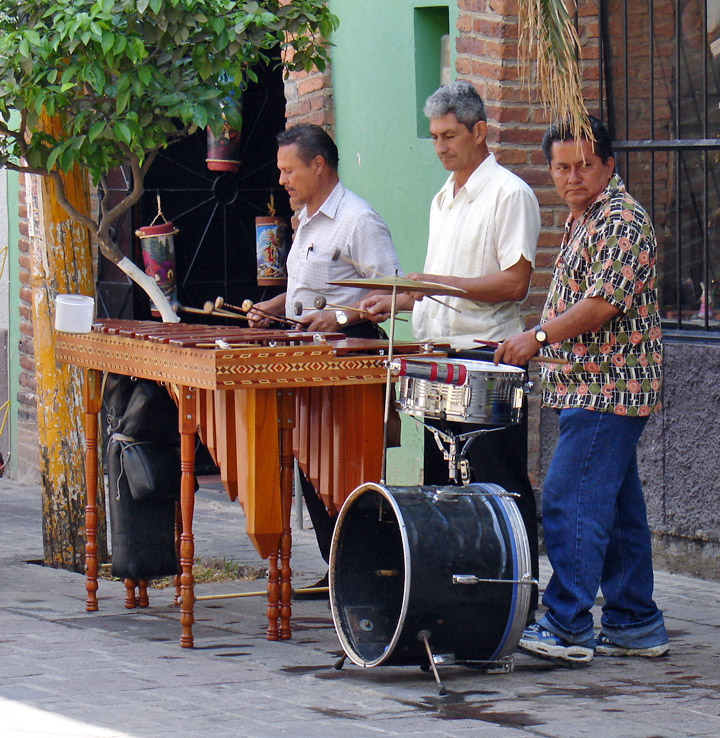 Folk and popular marimba Bars Marimba bars may be made either of wood or a synthetic fiberglass material. For the best sound quality, rosewood is the most desirable, while padauk is a popular affordable alternative. Synthetic fiberglass bars are often sold under trade names such as Kelon (for Ludwig-Musser), Klyperon (for J.C. Deagan), or Acoustalon (for Yamaha), among others. Bars made from synthetic materials generally fall short in sound quality and generally have a longer decay in comparison to wooden bars, but they are often less expensive and yield added durability and weather resistance, making them suitable for outdoor use. For wooden bars, changes in humidity or temperature may alter the moisture levels within the wood. This may negatively affect the pitch and tonality of the bar. Bubinga (Guibourtia demeusei) and mahogany have also been cited as comparable to rosewood in quality for use as marimba bars. The specific rosewood, Dalbergia stevensonii, only grows in Southern Guatemala and Belize, formerly British Honduras.[19] This wood has a Janka rating of 2200, which is about three times harder than silver maple. The bars are wider and longer at the lowest-pitched notes, and gradually get narrower and shorter as the notes get higher. During the tuning, wood is taken from the middle underside of the bar to lower the pitch. Because of this, the bars are also thinner in the lowest pitch register and thicker in the highest pitch register. While most American marimbas are tuned to the standard A4=440 Hz, many commercial marimbas are tuned to A4=442 Hz for a brighter sound for better blend with an orchestra.[20] Marimba bars produce their fullest sound when struck just off center, while striking the bar in the center produces a more articulate tone. On chromatic marimbas, the accidentals can also be played on the extreme front edge of the bar, away from the node (the place where the string goes through the bar) if necessary. Playing on the node produces a sonically weak tone, and the technique is only used when the player or composer is looking for a muted sound from the instrument.  Contrabass marimba: range of G1–G3  Bass marimba: range of C2–F3 Range There is no standard range of the marimba, but the most common ranges are 4.3 octaves, 4.5 octaves and 5 octaves; 4, 4.6 and 5.5 octave sizes are also available. 4 octave: C3 to C7. 4.3 octave: A2 to C7. The .3 refers to three semitones below the 4 octave instrument. This is the most common range. 4.5 octave: F2 to C7. The .5 means "half"; 4.6 octave: E2 to C7, one semitone below the 4.5. Useful for playing guitar literature and transcriptions. 5 octave: C2 to C7, one full octave below the 4 octave instrument, useful for playing cello transcriptions, e.g., J. S. Bach's cello suites. Bass range (varies, but examples range from G1–G3 or C2–F3) The range of the marimba has been gradually expanding, with companies like Marimba One adding notes up to F above the normal high C (C7) on their 5.5 octave instrument and marimba tuners adding notes lower than the low C on the 5 octave C2. Adding lower notes is somewhat impractical; as the bars become bigger and the resonators become longer, the instrument must be taller and the mallets must be softer in order to produce a tone rather than just a percussive attack. Adding higher notes is also impractical because the hardness of the mallets required to produce the characteristic tone of a marimba are much too hard to play with in almost any other, lower range on the instrument. The marimba is a non-transposing instrument with no octave displacement, unlike the xylophone, which sounds one octave higher than written, and the glockenspiel, which sounds two octaves higher than written. 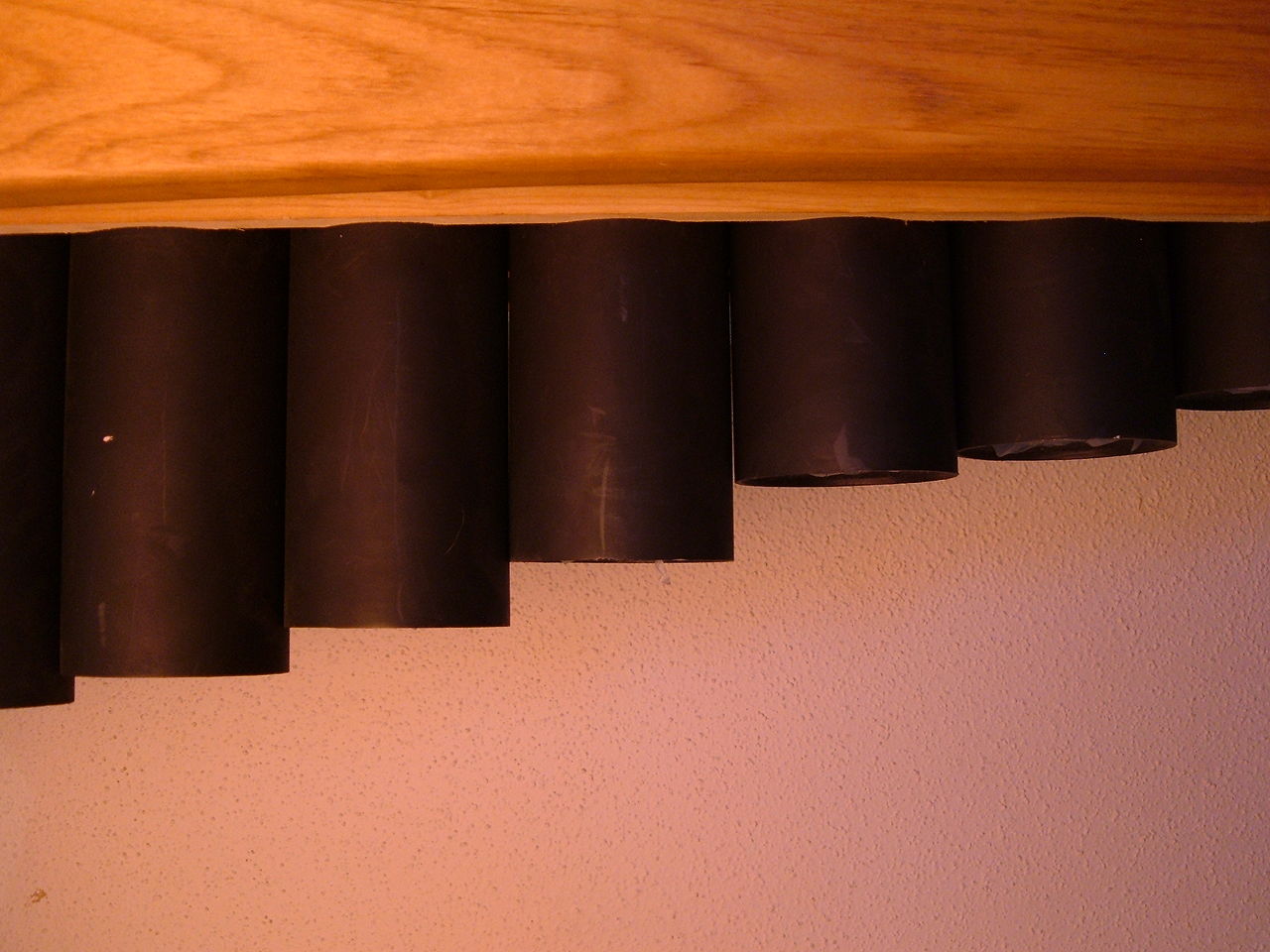 PVC resonators Resonators Part of the key to the marimba's rich sound are its resonators. These are tubes (usually aluminum) that hang below each bar. In the most traditional versions, various sizes of natural gourds are attached below the keys to act as resonators; in more sophisticated versions carved wooden resonators are substituted, allowing for more precise tuning of pitch. In Central America and Mexico, a hole is often carved into the bottom of each resonator and then covered with a delicate membrane taken from the intestine of a pig to add a characteristic "buzzing" or "rattling" sound known as charleo.[21] In more contemporary-style marimbas, wood is replaced by PVC tubing. The holes in the bottoms of the tubes are covered with a thin layer of paper to produce the buzzing noise. The length of the resonators varies according to the frequency that the bar produces. Vibrations from the bars resonate as they pass through the tubes, which amplify the tone in a manner very similar to the way in which the body of a guitar or cello would. In instruments exceeding 4+1⁄2 octaves, the length of tubing required for the bass notes exceeds the height of the instrument. Some manufacturers, such as DeMorrow and Malletech, compensate for this by bending the ends of the tubes. This involves soldering smaller straight sections of tubes to form "curved" tubes. Both DeMorrow and Malletech use brass rather than aluminium. Others, such as Adams and Yamaha, expand the tubes into large box-shaped bottoms, resulting in the necessary amount of resonating space without having to extend the tubes. This result is achieved by the custom manufacturer Marimba One by widening the resonators into an oval shape, with the lowest ones reaching nearly a foot in width, and doubling the tube up inside the lowest resonators—a process known as "Haskelling", originally used in pipe organ resonators, and named for its inventor, William E. Haskell. Resonator tuning involves adjusting "stops" in the tubes themselves to compensate for temperature and humidity conditions in the room where the instrument is stored. Some companies offer adjustment in the upper octaves only. Others do not have any adjustable stops. Still some companies (Malletech and DeMorrow) offer full-range adjustable stops. On many marimbas, decorative resonators are added to fill the gaps in the accidental resonator bank. In addition to this, the resonator lengths are sometimes altered to form a decorative arch, such as in the Musser M-250. This does not affect the resonant properties, because the end plugs in the resonators are still placed at their respective lengths. Mallets 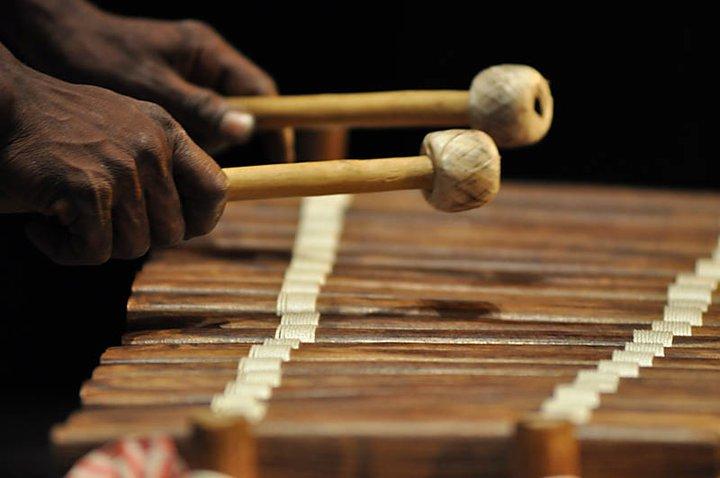 An example of the mallets used when playing a marimba The mallet shaft is commonly made of wood, usually birch, but may also be rattan or fiberglass. The most common diameter of the shaft is around 8 mm (5⁄16 in). Shafts made of rattan have a certain elasticity to them, while birch has almost no give. Professionals use both depending on their preferences, whether they are playing with two mallets or more, and which grip they use if they are using a four-mallet grip. Appropriate mallets for the instrument depend on the range. The material at the end of the shaft is almost always a type of rubber, usually wrapped with yarn. Softer mallets are used at the lowest notes, and harder mallets are used at the highest notes. Mallets that are too hard will damage the instrument, and mallets that might be appropriate for the upper range could damage the notes in the lower range (especially on a padouk or rosewood instrument). On the lower notes, the bars are larger, and require a softer mallet to bring out a strong fundamental. Because of the need to use varying hardnesses of mallets, some players, when playing with four or more mallets, might use graduated mallets to match the bars that they are playing (softer on the left, harder on the right). Some mallets, called "two-toned" or "multi-tonal", have a hard core, loosely wrapped with yarn. These are designed to sound articulate when playing at a loud dynamic, and broader at the quieter dynamics. |
構造 フォークとポピュラーのマリンバ バー マリンバのバーは、木製または合成繊維グラスファイバー製である。最高の音質を得るにはローズウッドが最適だが、手頃な価格の代替品としてはパドックが一 般的である。合成繊維グラスファイバー製のバーは、ケルン(Ludwig-Musser社)、クライペロン(J.C. Deagan社)、アコースタロン(Yamaha社)などの商品名で販売されていることが多い。合成素材でできたバーは、一般的に音質が劣り、木製バーに 比べて減衰時間が長い傾向があるが、価格が安く、耐久性と耐候性に優れているため、屋外での使用に適している。木製バーの場合、湿度や温度の変化により、 木材内の水分量が変化することがある。これにより、音程や音色に悪影響が出る可能性がある。 また、ブビンガ(Guibourtia demeusei)やマホガニーも、マリンバの棒としてローズウッドと同等の品質を持つとして挙げられている。特定のローズウッドである Dalbergia stevensonii は、グアテマラ南部およびベリーズ(旧イギリス領ホンジュラス)でしか生育しない[19]。この木材のヤンカ硬度は 2200 であり、これはシルバーメープルの約 3 倍の硬度である。音の高さが低い音程ほど、バーは幅広で長くなり、音が高くなるにつれて徐々に細く短くなる。チューニングの際には、音程を下げるために バーの下側中央から木材が削られる。このため、音程が低い音域ではバーが細く、高い音域では太くなっている。ほとんどのアメリカ製マリンバは標準的なA4 =440 Hzに調律されているが、オーケストラとの調和を考慮して明るい音色を出すために、多くの市販マリンバはA4=442 Hzに調律されている[20]。 マリンバの棒は、中心から少し外れた位置で叩くと最も豊かな音色を奏でるが、中心で叩くとより明瞭な音色になる。クロマチックマリンバでは、必要であれ ば、臨時記号を弦がマリンバ本体を通る場所である節から離れた、マリンバ本体の最も前方の端で演奏することもできる。節で演奏すると、音量が弱くなるた め、この奏法は、演奏者や作曲者が楽器から静かな音を求めている場合にのみ使用される。  コントラバス・マリンバ:G1~G3の音域  バス・マリンバ:C2~F3の音域 音域 マリンバの音域に標準的な範囲はないが、最も一般的なのは4.3オクターブ、4.5オクターブ、5オクターブである。 4オクターブ:C3~C7 4.3オクターブ: A2 から C7。.3 は、4 オクターブ楽器より 3 半音低いことを意味する。これは最も一般的な音域である。 4.5 オクターブ:F2 から C7。.5 は「半分」を意味する。 4.6 オクターブ:E2 から C7。4.5 より半音低い。ギター曲や編曲作品の演奏に便利。 5 オクターブ: C2 から C7、4 オクターブ楽器の 1 オクターブ下、J. S. バッハのチェロ組曲などのチェロ編曲演奏に有用。 低音域(幅は様々だが、G1~G3またはC2~F3が一般的 マリンバの音域は徐々に拡大しており、Marimba One社では、5.5オクターブの楽器で通常の最高音C(C7)より上のFまでの音符を追加し、マリンバのチューナーでは、5オクターブのC2で最低音C より低い音符を追加している。低い音を加えることは、ある程度非現実的である。バーが大きくなり、共鳴器が長くなるにつれ、楽器はより背が高くなり、マ レットはより柔らかくなければならない。高い音を加えることも非現実的である。なぜなら、マリンバの特徴的な音色を出すのに必要なマレットの硬度は、楽器 の他のほとんどの下音域では演奏するには硬すぎるからである。 マリンバは、1オクターブ高く鳴るシロフォンや2オクターブ高く鳴るグロッケンシュピールとは異なり、移調機能のない楽器であり、オクターブ移動機能がない。  PVCレゾネーター レゾネーター マリンバの豊かな音色を生み出す鍵の一つはレゾネーターである。これは、各バーの下部にぶら下げられたチューブ(通常はアルミニウム製)である。 最も伝統的なバージョンでは、さまざまな大きさの天然のひょうたんが鍵盤の下に取り付けられ、共鳴器として機能している。より洗練されたバージョンでは、 木製の共鳴器が取り付けられ、より正確な音程調整が可能になっている。中米やメキシコでは、共鳴器の底に穴を開け、豚の腸から取った繊細な膜で覆い、チャ レロと呼ばれる特徴的な「ブーン」や「ガラガラ」という音を出すことが多い[21]。より現代的なスタイルのマリンバでは、木材がPVCチューブに置き換 えられている。チューブの底の穴は、ブーンという音を出すために薄い紙で覆われている。 共鳴器の長さは、バーが作り出す周波数によって異なる。バーから発せられた振動はチューブを通過する際に共鳴し、ギターやチェロの胴体で音を増幅させるの と非常に似た方法で音を増幅させる。4オクターブ半を超える楽器では、低音域に必要なチューブの長さが楽器の高さを超える。DeMorrowや Malletechなどのメーカーは、管の端を曲げることでこの問題を解決している。これは、管の小さい直線部分をハンダ付けして「湾曲した」管を形成す る方法である。DeMorrowとMalletechはどちらもアルミニウムではなく真鍮を使用している。一方、AdamsやYamahaなどのメーカー は管を大きな箱型の底部に拡張することで、管を延長せずに必要な共振空間を確保している。この方法は、カスタムメーカーであるマリンバ・ワンが、共鳴器を 楕円形に広げることで実現している。最も低い共鳴器は幅が30センチ近くに達し、最も低い共鳴器の内側にチューブを二重にすることで、パイプオルガンの共 鳴器で用いられ、その発明者であるウィリアム・E・ハスケルにちなんで「ハスケリング」と呼ばれるプロセスを実現している。 共鳴器のチューニングには、楽器が保管されている部屋の温度や湿度の変化を補正するために、管自体の「ストップ」を調整することが含まれる。 いくつかの会社は、高音域のみを調整できるものもある。 調整可能なストップを一切持たない会社もある。 それでも、Malletech社やDeMorrow社など、全音域の調整可能なストップを提供している会社もある。 多くのマリンバでは、装飾用の共鳴器が、偶発的な共鳴器バンクの隙間を埋めるために追加されている。これに加えて、ムッサー M-250 のように装飾的なアーチを形成するためにレゾネーターの長さを変更することもあります。レゾネーター内のエンドプラグはそれぞれの長さに置かれているた め、これは共鳴特性に影響を与えません。 マレット  マリンバ演奏時に使用されるマレットの例 マレットのシャフトは通常、木材(通常はバーチ材)製ですが、籐製やファイバーグラス製のものもあります。最も一般的なシャフトの直径は8mm(5⁄16 インチ)前後である。籐製のシャフトは弾力性があるが、バーチ材はほとんど弾力性がない。プロは、2本またはそれ以上のマレットを使用するか、4本マレッ トグリップを使用する場合はどのグリップを使用するかなど、好みに応じて両方を併用する。 楽器に適したマレットは音域によって異なる。シャフトの先端の素材は、ほとんどの場合ゴム製で、通常糸で巻かれている。低い音域では柔らかいマレットを使 用し、高い音域では硬いマレットを使用する。マレットが硬すぎると楽器を傷める原因となり、高い音域に適したマレットを使用すると、低い音域の音を損なう 可能性がある(特にパドゥクやローズウッドの楽器の場合)。低音域では棒が太いため、強い基本音を出すには柔らかいマレットが必要です。マレットの硬さを 変える必要があるため、4本以上のマレットで演奏する一部の奏者は、演奏する棒に合わせてマレットを段階的に使い分けることがあります(左は柔らかく、右 は硬く)。 「ツートーン」または「マルチトーン」と呼ばれるマレットの中には、硬い芯を糸でゆるく巻いたものがある。これらは、大きな強弱で演奏する際に明瞭な音色、小さな強弱で演奏する際に幅広い音色を出すように設計されている。 |
| Mallet technique Modern marimba music calls for simultaneous use of between two and four mallets (sometimes up to six or eight), granting the performer the ability to play chords or music with large interval skips more easily. Multiple mallets are held in the same hand using any of a number of techniques or "grips". For four mallets (two mallets in each hand), the most common grips are the Burton grip (made popular by Gary Burton), the traditional grip (or "cross grip") and the Musser-Stevens grip (made popular by Leigh Howard Stevens). Each grip is perceived to have its own benefits and drawbacks. For example, some marimbists feel the Musser-Stevens grip is more suitable for quick interval changes and mallet independence, while the Burton grip is more suitable for stronger playing or switching between chords and single-note melody lines. The traditional grip gives a greater dynamic range and freedom of playing. The choice of grip varies by region (the Musser-Stevens grip and the Burton grip are more popular in the United States, while the traditional grip is more popular in Japan), by instrument (the Burton grip is less likely to be used on marimba than on a vibraphone) and by the preference of the individual performer.[22] Six-mallet grips consist of variations on these three grips. Six-mallet marimba grips have been used for years by Mexican and Central American marimbists, but they are generally considered non-standard in the Western classical canon. Keiko Abe has written a number of compositions for six mallets, including a section in her concerto Prism Rhapsody. Other marimbists/composers using this technique include Rebecca Kite (who commissioned composer Evan Hause to write Circe, a major work for six mallets, in 2001), Dean Gronemeier, Robert Paterson, and Kai Stensgaard. Paterson's grip is based on the Burton grip, and his grip and technique have been called the Paterson grip, and even the Wolverine grip. Paterson states that his technique differs from others in that there is less emphasis places on block chords on the lower bank of notes (the naturals or white notes) and more emphasis on independence, one-handed rolls, and alternations between mallets 12-3 or 1–23 in the left hand (or 45-6 or 4–56 in the right hand, respectively), and so on. Ludwig Albert published at first a work for eight mallets and demonstrated the Ludwig Albert eight-mallet grip based on the traditional grip from 1995.[citation needed] |
マレット奏法 現代のマリンバ音楽では、2本から4本のマレット(時には6本や8本)を同時に使い、演奏者が和音や音程が大きく跳躍する音楽を演奏しやすくしている。複 数のマレットは、さまざまな奏法や「グリップ」を用いて同じ手で保持される。4本のマレット(両手に2本ずつ)を使用する場合、最も一般的なグリップは、 ゲイリー・バートンによって広まったバートン・グリップ、伝統的なグリップ(または「クロス・グリップ」) 、そしてリー・ハワード・スティーブンスによって広まったマッサー・スティーブンス・グリップである。それぞれのグリップには、それぞれ長所と短所がある と考えられている。例えば、マラービストの中には、マッスー・スティーブンス・グリップは速い音程変化やマレットの独立性に適しており、バートン・グリッ プは力強い演奏や和音と単音旋律の切り替えに適していると感じている人もいる。 伝統的なグリップは、より広いダイナミックレンジと演奏の自由度をもたらす。グリップの選択は地域(米国ではマッサー・スティーブンス・グリップとバート ン・グリップが、日本では伝統的なグリップが一般的)や楽器(バートン・グリップはマリンバよりもヴィブラフォンで使用されることが多い)によって、また 演奏者個人の好みによっても異なる[22]。 6本マレットのグリップは、これら3つのグリップのバリエーションから構成される。6本マレットのマリンバ用グリップは、メキシコや中米のマリンビストが 長年使用してきたが、西洋クラシック音楽では一般的に標準的ではないと考えられている。阿部圭子は、6本マレット用の曲を多数作曲しており、その中には彼 女のコンチェルト『プリズム・ラプソディ』の一節も含まれている。この奏法を使用する他のマリンビスト/作曲家には、レベッカ・カイト(2001年に作曲 家エヴァン・ハウゼに6本のマレットを使用する主要作品『Circe』の作曲を依頼した)、ディーン・グローネマイヤー、ロバート・パターソン、カイ・ス テンガードなどがいる。パターソンの奏法はバートン奏法をベースにしており、彼の奏法や奏法はパターソン奏法、あるいはウルヴァリン奏法とも呼ばれる。パ ターソンは、彼の奏法は他の奏法と異なり、低音部(ナチュラルまたは白音)のブロックコードをあまり重視せず、左手での12-3または1-23のマレット の交替(または右手での45-6または4-56の交替)など、独立性、片手ロール、マレットの交替をより重視していると述べている。ルートヴィヒ・アルベ ルトは、最初は8本のマレットを使用する作品を出版し、1995年から従来のグリップをベースにしたルートヴィヒ・アルベルト8本マレット・グリップを披 露した[出典が必要]。 |
Repertoire A marimba player for the NDR Radiophilharmonie Orchestra The marimba is less used by composers than other keyboards from orchestral percussion section, although its interest increased after 1950 such as in Le marteau sans maître by Pierre Boulez.[23] Concertos The first solo marimba concerto, Concertino for Marimba, was composed by Paul Creston in 1940, after a commission by Frédérique Petrides. The Concertino for Marimba premiered on 29 April 1940 in Carnegie Hall with marimba soloist Ruth Stuber Jeanne and the Orchestrette Classique.[24] The second concerto for the marimba, Concerto for Marimba, Vibraphone and Orchestra, was written by Darius Milhaud in 1947.[25] The Oregon Symphony Orchestra commissioned Tomáš Svoboda to compose Concerto for Marimba and Orchestra, Op. 148, in 1995.[26] A recording of the piece by the orchestra and Niel DePonte was nominated for the 2004 Grammy Award for Best Instrumental Soloist(s) Performance (with orchestra).[27] Other prominent concertos include Concerto No. 1 for Marimba and String Orchestra written in 1986 by Ney Rosauro and Concerto for Marimba and String Orchestra written in 2006 by Emmanuel Séjourné.[28] Solos The marimba is the most popular solo keyboard percussion instrument in classical music. Popular marimba solos range from beginner solos such as Yellow After the Rain and Sea Refractions by Mitchell Peters to more advanced works such as Variations on Lost Love by David Maslanka, Rhythmic Caprice by Leigh Howard Stevens and Khan Variations by Alejandro Viñao.[29] |
レパートリー NDRラジオフィルハーモニー管弦楽団のマリンバ奏者 オーケストラ マリンバは、オーケストラの打楽器セクションの他の鍵盤楽器よりも作曲家によって使用されることは少ないが、1950年以降、ピエール・ブーレーズ作曲の『ル・マルトー・サン・メートル』など、その関心が高まった[23]。 協奏曲 最初のソロマリンバ協奏曲『Concertino for Marimba』は、フレデリック・ペトリデスからの委嘱を受けて、ポール・クレストンが1940年に作曲した。マリンバ協奏曲は、1940年4月29日 にカーネギーホールでマリンバ奏者のルース・スタバー・ジーンとオーケストラ・クラシークの共演により初演された[24]。マリンバのための2つ目の協奏 曲である「マリンバ、ヴィブラフォンとオーケストラのための協奏曲」は、ダリウス・ミヨーが1947年に作曲した[25]。 オレゴン交響楽団は、1995年にトマーシュ・スボダに委嘱し、マリンバとオーケストラのための協奏曲作品148を作曲した[26]。この曲は、同楽団と ニール・デポンテによる演奏が、2004年のグラミー賞の「最優秀器楽独奏者(オーケストラ伴奏)」部門にノミネートされた[27]。 )。[27] その他の著名な協奏曲には、1986年にネイ・ロザウロが作曲したマリンバと弦楽オーケストラのための協奏曲第1番、2006年にエマニュエル・セジュネが作曲したマリンバと弦楽オーケストラのための協奏曲がある[28]。 独奏 マリンバはクラシック音楽において最も人気のある鍵盤打楽器である。人気の高いマリンバ独奏曲は、ミッチェル・ピーターズによる『Yellow After the Rain』や『Sea Refractions』などの初心者向けの曲から、デヴィッド・マスランカの『Variations on Lost Love』、リー・ハワード・スティーブンスの『Rhythmic Caprice』、アレハンドロ・ヴィニャオの『Khan Variations』などの上級者向けの曲まで幅広い。 |
| Popular music Folk marimba with gourds, Highland Guatemala Traditional marimba bands are especially popular in Guatemala, where they are the national symbol of culture, but are also strongly established in the Mexican states of Chiapas, Tabasco, and Oaxaca. They are also very popular in other Central American nations such as Honduras, El Salvador, Nicaragua, and Costa Rica, as well as among Afro-Ecuadorians and Afro-Colombians.[30] There have been numerous jazz vibraphonists who also played the marimba. Notable among them are Gary Burton, David Friedman, Stefon Harris, Bobby Hutcherson, Joe Locke, Steve Nelson, Red Norvo, Dave Pike, Gloria Parker, Dave Samuels, and Arthur Lipner.[citation needed] Marimbist and vibraphonist Julius Wechter was the leader of a popular 1960s Latin-flavored band called Baja Marimba Band. Herb Alpert and his Tijuana Brass made frequent use of the marimba.[31] Ruth Underwood played an electrically amplified marimba in Frank Zappa's The Mothers of Invention.[32] The Rolling Stones' 1966 song "Under My Thumb" prominently features a marimba, played by Brian Jones. A marimba solo was in the hit 1975 Starbuck song "Moonlight Feels Right". The 1982 Toto hit “Africa” prominently features the marimba, played by Jeff Porcaro. The version of the song “Tonight” by David Bowie and Iggy Pop featured on Bowie’s 1984 album of the same title includes a marimba. Peter Gabriel's 1985 soundtrack album Birdy includes the song "Slow Marimbas." |
ポピュラー音楽 ヒョウタンを使ったフォーク・マリンバ、グアテマラ高地 伝統的なマリンババンドは、グアテマラで特に人気があり、グアテマラの文化の象徴となっているが、メキシコのチアパス州、タバスコ州、オアハカ州でも広く 定着している。また、ホンジュラス、エルサルバドル、ニカラグア、コスタリカといった中米諸国や、エクアドルやコロンビアのアフリカ系住民の間でも非常に 人気がある[30]。 マリンバを演奏するジャズ・ヴィブラフォン奏者も数多くいる。著名な人物としては、ゲイリー・バートン、デヴィッド・フリードマン、ステフォン・ハリス、 ボビー・ハッチャーソン、ジョー・ロック、スティーブ・ネルソン、レッド・ノーヴォ、デイヴ・パイク、グロリア・パーカー、デイヴ・サミュエルズ、アー サー・リプナーなどが挙げられる。 マリンバ奏者でありヴィブラフォン奏者でもあるジュリアス・ウェクターは、1960年代に人気を博したラテン音楽バンド、バハ・マリンバ・バンドのリーダーを務めていた。ハーブ・アルパートとティファナ・ブラスはマリンバを頻繁に使用していた[31]。 ルース・アンダーウッドは、フランク・ザッパのザ・マザーズ・オブ・インヴェンションで電気増幅マリンバを演奏していた[32]。 ローリング・ストーンズの1966年の曲「アンダー・マイ・サム」では、ブライアン・ジョーンズが演奏するマリンバが顕著にフィーチャーされている。 1975年のスターバックスのヒット曲「ムーンライト・フィールズ・ライト」では、マリンバのソロがフィーチャーされている。 1982年のヒット曲「Africa」では、ジェフ・ポーカロが演奏するマリンバが印象的に使われている。 デヴィッド・ボウイとイギー・ポップによる「Tonight」は、1984年に発売された同名のアルバムに収録されているが、この曲にもマリンバが用いられている。 ピーター・ガブリエルの1985年のサウンドトラックアルバム「Birdy」には、「Slow Marimbas」という曲がある。 |
Quadrangularis Reversum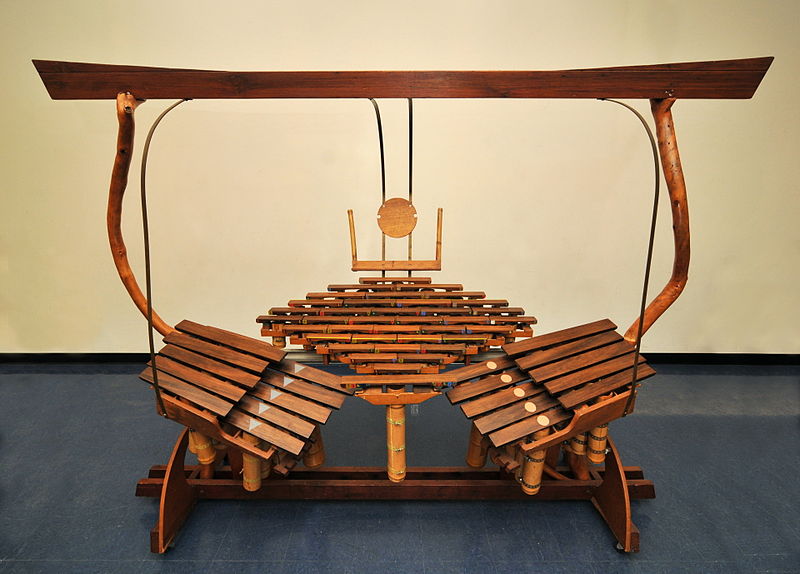 Quadrangularis Reversum Partch built the Quadrangularis Reversum in 1965, about twenty years after the Diamond Marimba.[15] The central section's 36 African padauk blocks are an upside-down, mirrored version of the Diamond Marimba—hence Reversum. This reverse possibility was shown to Partch by Erv Wilson who helped with its construction. To the left and right are sets of ten alto-register blocks.[19] Bamboo resonators are under the blocks. Partch's initial plan, abandoned due to cost, was to use square bamboo (C. quadrangularis) for the resonators—hence the first part of the instrument's name.[22] The curved uprights are eucalyptus, and the bar across the top is intended to evoke a torii. The instrument is quite large at 103 inches (2.6 m) across the top and 79 inches (2.0 m) tall.[23] https://en.wikipedia.org/wiki/Instruments_by_Harry_Partch |
Quadrangularis Reversum Quadrangularis Reversum パートチは、ダイヤモンド・マリンバの20年後の1965年にクアドラングラリス・レヴァースムを製作した[15]。中央部の36個のアフリカ産パドゥク 材ブロックは、ダイヤモンド・マリンバを上下逆さまに鏡像反転させたものである。この逆の可能性は、その製作を手伝ったアーヴ・ウィルソンによってパート チに示された。左右には、10個のアルトレジスターブロックが配置されている[19]。ブロックの下には竹製の共鳴器がある。コストの問題で断念された パートチの当初の計画では、共鳴器に四角い竹(C. quadrangularis)を使用することになっていた。これが楽器名の最初の部分となっている[22]。湾曲した支柱はユーカリ製で、上部に渡され たバーは鳥居をイメージしたものである。この楽器は、横幅が103インチ(2.6メートル)、高さが79インチ(2.0メートル)とかなり大きい [23]。 |
リ ンク
文 献
そ の他の情報
Copyleft, CC, Mitzub'ixi Quq Chi'j, 1996-2099
☆
 ☆
☆